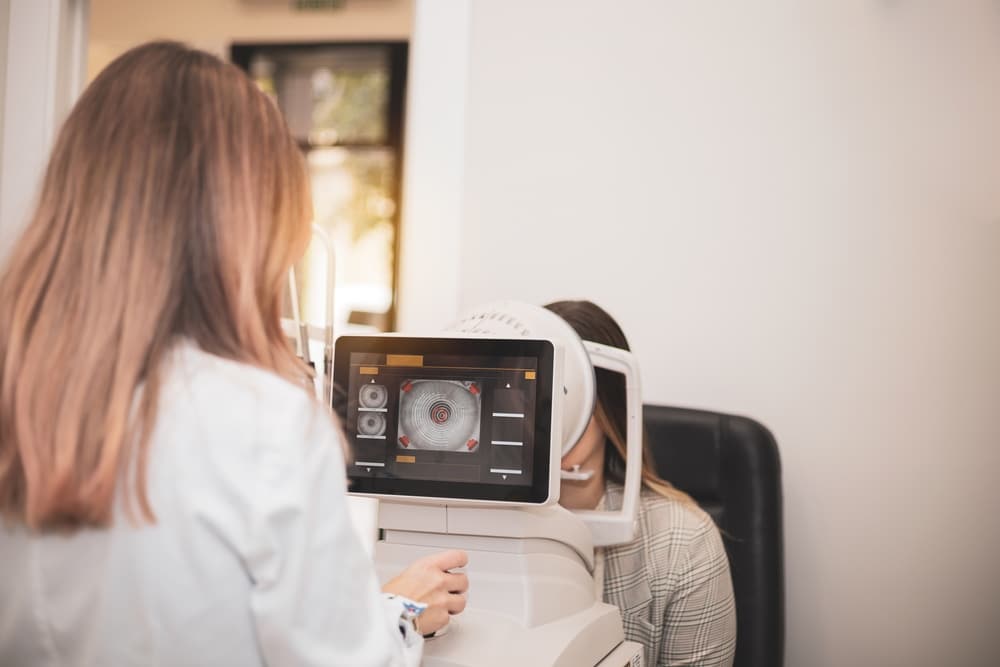
Fuchs’ corneal dystrophy is a common eye condition that affects the cornea, the clear front surface of the eye. As the eye condition progresses, vision can become blurry, and corneal transplants may be required.
While any eye doctor can diagnose Fuchs’ dystrophy, treatment options vary depending on the severity of the condition. Keep reading to learn more about Fuch’s dystrophy and whether or not any eye doctor can treat this eye condition!
What is Fuchs’ Corneal Dystrophy?
Fuchs’ dystrophy is a progressive eye condition that affects the cornea, where cells in the innermost corneal layer gradually deteriorate. Healthy endothelial cells are essential for keeping the cornea clear.
As these cells die off, the cornea swells and becomes fluid-filled, which leads to a cloudy, blurred vision. Later in the eye condition, painful corneal blisters, called bullae, can form.
Fuchs’ dystrophy usually affects both eyes, but often progresses faster in one eye. It primarily impacts people over the age of forty and is slightly more common in women.
Fuchs’ corneal dystrophy can significantly affect vision and quality of life.
What Are the Most Common Symptoms of Fuchs’ Dystrophy?
The most common symptoms of Fuchs’ corneal dystrophy are blurred, cloudy vision and eye pain from fluid-filled blisters on the cornea called bullae. Both symptoms result from swelling of the cornea as endothelial cells degenerate over time.
Who Can Treat Fuch’s Dystrophy?
In the early stages of Fuchs’ dystrophy, any eye doctor can diagnose the condition with a comprehensive eye exam. However, an ophthalmologist, a medical doctor specializing in eye conditions, is needed for more advanced cases that may require surgery.
It’s best to see your eye doctor regularly if you are diagnosed with Fuchs’ corneal dystrophy. They can closely monitor your vision and determine if and when you need treatment.
Is Fuchs’ Dystrophy Common?
Fuchs’ dystrophy is relatively common. Most people with early Fuchs’ dystrophy do not have many symptoms and may not know they have the condition.
As the eye condition worsens, symptoms like blurred vision, sensitivity to light, and eye pain from bullae make it more apparent. Family history is a risk factor for Fuchs’ dystrophy.
How is Fuchs’ Dystrophy Treated?
In mild cases, eye doctors may choose to only monitor the condition. However, in later stages or in more advanced cases where the condition is beginning to affect vision, surgery will be necessary.
Partial Thickness Cornea Transplant
During this procedure, new endothelial cells are transplanted onto the back surface of the cornea. This helps it function normally again.
Full Thickness Cornea Transplant
During this procedure, the entire affected portion of the cornea is removed and replaced with a healthy donated cornea.
With proper monitoring and treatment from an experienced ophthalmologist, the vision loss from Fuchs’ corneal dystrophy can be stopped or reversed. Early diagnosis and intervention provides the best outcomes.
While any eye doctor can recognize the signs of Fuchs’ dystrophy, it’s best to see a corneal specialist for treatment. Corneal specialists have the training and expertise to ensure you are on the best treatment regiment and monitor your condition.
Are you experiencing vision changes? Schedule an appointment at Colorado Eye Consultants in Littleton, CO, today!

